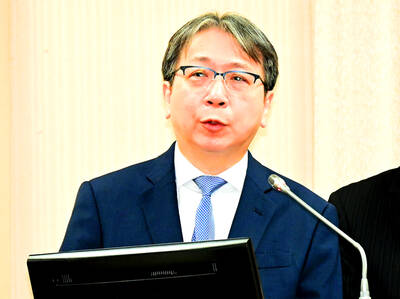A US congressional committee was told on Wednesday that Taiwan needed more advanced fighter aircraft and diesel submarines to defend itself against a possible attack by China.
Testifying before the US House of Representatives Committee on Foreign Affairs, Larry Wortzel, a specialist on the Chinese and Taiwanese military, said that despite a notable improvement in relations across the Taiwan Strait, Beijing continues to insist on its right to use force should Taiwan move toward independence.
“The cross-strait military balance increasingly favors China. Beijing has deployed over 1,100 short-range ballistic missiles opposite the island. In my view, Taiwan’s most pressing need is for new or modernized fighter aircraft,” Wortzel said.
Wortzel was speaking at a committee briefing on “China’s behavior and its impact on US interests” held on the first day of Chinese President Hu Jintao’s (胡錦濤) state visit to Washington.
Republican Representative David Rivera described Taiwan as “a bastion of democracy surrounded by a fortress of tyranny.”
NEW OR EXISTING
Wortzel said the big question was whether to sell Taipei F-16C/D aircraft, which have a long range and could be used for deep strikes inside China “if their [Taiwan’s] military chose to do that” or modernize the existing F-16A/B aircraft that Taiwan already possesses.
He said that he had talked with aviation engineers who thought that with the addition of brand new avionics, radar and targeting equipment, the A/Bs could be converted into “very capable aircraft.”
“They need the aircraft and I think they have to have that need addressed,” Wortzel said.
Representative Gerry Connolly, a Democrat, asked if there was any reason to believe that Taiwan was not capable of defending itself in case of an invasion.
“I don’t think that is the issue,” Wortzel said. “The issue is how capable would they be in doing it. They would have a hard time defending against 1,100 ballistic missiles. The missiles would do a lot of damage. They would be hard pressed if there were massive special operations insertions into Taiwan to disrupt the infrastructure.”
He said Taiwan could do more to strengthen airfields and storage facilities.
“If there is one thing they could do to immediately improve their capabilities, it would be to link all of their ground, naval, air assets and missiles so they could take part in cooperative target engagements,” Wortzel said. “They are developing their own multiple launch rocket systems and could probably use assistance with precision guided rounds.”
SUBMARINES
Asked about submarines, Wortzel said: “It’s a very difficult problem ... It’s a problem for the US Navy because we really don’t want to work on, or produce, diesel submarines, but they need these submarines.”
“The United States could get Costa Rica to buy a dozen submarines from Germany and then transfer them and it wouldn’t hurt anybody — if the Germans would look the other way on the re-transfer,” he said.

The US government has signed defense cooperation agreements with Japan and the Philippines to boost the deterrence capabilities of countries in the first island chain, a report by the National Security Bureau (NSB) showed. The main countries on the first island chain include the two nations and Taiwan. The bureau is to present the report at a meeting of the legislature’s Foreign Affairs and National Defense Committee tomorrow. The US military has deployed Typhon missile systems to Japan’s Yamaguchi Prefecture and Zambales province in the Philippines during their joint military exercises. It has also installed NMESIS anti-ship systems in Japan’s Okinawa

TRAGEDY STRIKES TAIPEI: The suspect died after falling off a building after he threw smoke grenades into Taipei Main Station and went on a killing spree in Zhongshan A 27-year-old suspect allegedly threw smoke grenades in Taipei Main Station and then proceeded to Zhongshan MRT Station in a random killing spree that resulted in the death of the suspect and two other civilians, and seven injured, including one in critical condition, as of press time last night. The suspect, identified as a man surnamed Chang Wen (張文), allegedly began the attack at Taipei Main Station, the Taipei Fire Department said, adding that it received a report at 5:24pm that smoke grenades had been thrown in the station. One man in his 50s was rushed to hospital after a cardiac arrest

‘WIN-WIN’: The Philippines, and central and eastern European countries are important potential drone cooperation partners, Minister of Foreign Affairs Lin Chia-lung said Minister of Foreign Affairs Lin Chia-lung (林佳龍) in an interview published yesterday confirmed that there are joint ventures between Taiwan and Poland in the drone industry. Lin made the remark in an exclusive interview with the Chinese-language Liberty Times (the Taipei Times’ sister paper). The government-backed Taiwan Excellence Drone International Business Opportunities Alliance and the Polish Chamber of Unmanned Systems on Wednesday last week signed a memorandum of understanding in Poland to develop a “non-China” supply chain for drones and work together on key technologies. Asked if Taiwan prioritized Poland among central and eastern European countries in drone collaboration, Lin

ON ALERT: Taiwan’s partners would issue warnings if China attempted to use Interpol to target Taiwanese, and the global body has mechanisms to prevent it, an official said China has stationed two to four people specializing in Taiwan affairs at its embassies in several democratic countries to monitor and harass Taiwanese, actions that the host nations would not tolerate, National Security Bureau (NSB) Director-General Tsai Ming-yen (蔡明彥) said yesterday. Tsai made the comments at a meeting of the legislature’s Foreign Affairs and National Defense Committee, which asked him and Minister of National Defense Wellington Koo (顧立雄) to report on potential conflicts in the Taiwan Strait and military preparedness. Democratic Progressive Party (DPP) Legislator Michelle Lin (林楚茵) expressed concern that Beijing has posted personnel from China’s Taiwan Affairs Office to its